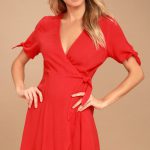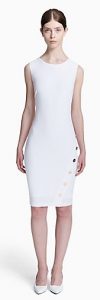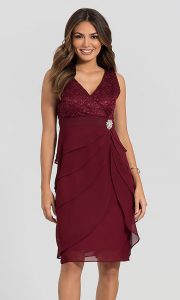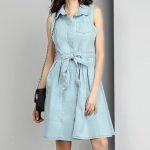The Occasional Woman: Dress Styles
Well, hey there, readers! I was talking to Angela Gardner the other day, and she made a great point — Dresses are fabulous. She’s right! They can hide a multitude of sins, make us look taller, softer, more confident and just nice. But what kinds of dresses are we talking about here? And why should we know most of the styles there are? I’ll tell you why. Cuz learning new stuff makes us smarter, and means we get the opportunity to sound really intelligent and classy. And like we know what we’re talking about.
So — here’s some basic info on dress styles! Dresses have been used since the beginning of time; their function is to keep us warm, hide our naughty bits, and make us look attractive to other humans. The first dresses were probably fur, because it existed! Then people magically discovered that if they grew plants, shredded them up and invented weaving, they could make CLOTHING! And, it was good.
The first garments were just rectangles of cloth, with arm head and leg openings, and other rectangles that got wrapped around folks. Then fashion happened, and shame, and clothing got more interesting! Ruffs, codpieces, sleeves that tied on to the rectangles, PANTS, no pants..
So, where does that leave us now? Several basic styles of dress are in use, most defined by form, function, ease of highlighting figure pluses, and minimizing flaws. Here are some of them:
The shift dress is basically a rectangle — does not have a well-defined waist, or sleeves. It should skim the body, not look like a sausage casing or an 8-person tent. This is the basis for what is known as a Little Black Dress — it is simple, and is mostly defined by accessories, the type and richness of the fabric and what shoes you wear with it.
A sheath dress is cut similarly but with a more fitted waistline.
The Empire Waist — generally pronounced “om-PEER” waist dress. In this style, the plainness of the sheath is broken up by cutting the shift’s rectangle just below the bust, a.k.a. the boobage. this can make the wearer appear less tall, and more curvy. The top part, known as the “bodice” is usually well-fitted, close to the body, and the skirt (the lower half of the dress) can be anywhere from slim to a big bubble. It does look good on most ladies.
Next in the basic category would be the Shirtwaist; this denotes another non-rectangular garment that has a defined waist. If YOU have a curvy figure, with a nipped-in waist, this is a natural for you! If you don’t, this kind of frock can make you look like you do! The lower half can be wide and fluffy, emphasizing curviness, or slim, which makes one look classy.
Which brings us to the Drop-waist dress; it was most popular in the 1920s, and in the 1960s. It elongates the figure, and works best on slim and small-hipped ladies. It can really look awful on most other human beings, so I’d skip it.
 The last one I want to mention is the Wrap Dress, made most popular by Diane Von Furstenberg, in the 1980s. It wraps around the wearer, hence the name. This one is tricky, as it has got to STAY wrapped to be decent! But it can be a great option if the wearer pays attention, ties it well, and stays sober.
The last one I want to mention is the Wrap Dress, made most popular by Diane Von Furstenberg, in the 1980s. It wraps around the wearer, hence the name. This one is tricky, as it has got to STAY wrapped to be decent! But it can be a great option if the wearer pays attention, ties it well, and stays sober.
Obviously, there are billions of permutations in the dress world; this column is just to familiarize the reader with some shape basics. Next time, we’ll explore further dress details, styles and when to wear them. Have a swell start to Autumn!
If you have need of a costume or a special dress, or need alterations on something you already own, contact Lorraine Anderson via email.
Care to make a comment on this post? Login here and use the comment area below.
Category: Style, Transgender Fashion
















The shift, the sheath and the wrap-around are probably the most useful for crossdressers, although the bodycon dress would probably rate higher with our fetish dressers. There are a lot more silhouettes of interest as well as a whole range of necklines which you can see here https://www.sisterhouse.net/library/category/all-about/dresses/?numtoshow=3&archive=yes.
The dress is so comfortable and so feminine that I’m puzzled as to why so many cis-women prefer jeans/leggings/pants
Hugs….Tasi